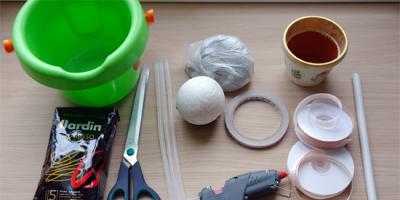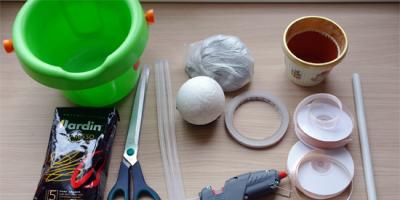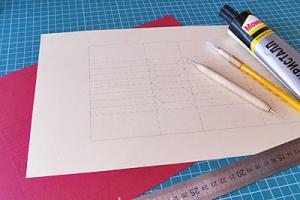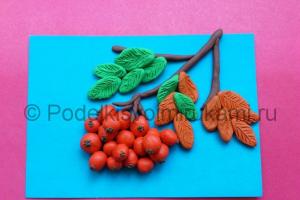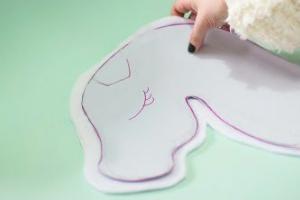If you make furniture yourself from laminated chipboard or MDF, then after cutting the sheets you need to protect their end parts, which will increase the service life of the product and give it a beautiful appearance. appearance. For this purpose, PVC furniture edges are often used, but there are other varieties. In this article we will talk about all the types, the need for edging and how to glue it yourself.
Self-adhesive furniture edge - a narrow strip of melamine, polyvinyl chloride, ABS plastic or other material. It protects and decorates the cut area. When producing cheap furniture from laminated chipboard, an edge is simply necessary, as it protects people from exposure to harmful formaldehyde. In addition, it gives strength and protects the material from moisture getting inside.
Types of edges
The most popular types are: furniture edge.
- Melamine edge with glue is the most budget-friendly, but not the highest quality type. It is afraid of moisture and can fall off over time (even without mechanical impact), easily crack and wear off at the corners. The only plus is the pre-applied layer of adhesive, so melamine edging remains a popular option at home.
- Furniture edging made of PVC 2 and 0.4 mm is best option. It is much more stable and durable. A thickness of 0.4 mm is usually used to process hidden places, and 2 mm is glued to the outer ends that will be visible. However, its application requires a special edge processing machine, so it is used only in production.
- The edge made of ABS plastic is a more environmentally friendly analogue of the previous option, which is less common on sale.
- Mortise T-profile - inserted into a milled groove at the end of the chipboard. It was popular in those days when a special machine for PVC edges was rare, and there were plenty of milling machines in the shops.
- The C18 U-profile overlay is a good option because it can be used for chipboard at home. Usually the C18 U-profile is simply put on the end and glued to liquid nails. The downside is that the edges protrude a few millimeters, under which dirt gets clogged. On the other hand, this feature is very convenient if you do cutting chipboard with your own hands, large edges will hide uneven cuts and chips. This type is often used for.
- PVC edge 2 mm – 40 rub.;
- PVC edging 0.4 mm – 25 rubles;
- edge for melamine chipboard – 25 rubles;
- You will have to pay additionally for processing curved areas.
- On the internal inset shelf, only the front edge is treated with a layer of 2 mm.
- The top cover is on all sides (the back edge is 0.4 mm, the rest - 2 mm).
- The drawer front is processed on all sides with a thickness of 2 mm.

When purchasing furniture, it is important to pay attention to the quality of finishing of the ends. It is better not to buy furniture treated with melamine, as it will not last long.
 Mortise T-edge
Mortise T-edge  Profile C18
Profile C18
For gluing on the machine, use a special hot melt adhesive for PVC edges. It is sold in granule form and becomes liquid when heated. The adhesive is applied to the tape either when heated or during the production of the tape.
Chipboard edges
To ensure that your countertop or cabinet edge is beautiful and durable, in the best possible way will order edging at production. This is usually done in the same place where laminated chipboards are purchased and ordered.
Approximate prices for application (per 1 linear meter along with the material):
The most popular PVC edge in Russia is Rehau, it has wide choose color range, so you can choose a color to match any chipboard. The width of the tape varies - from 15 to 45 mm. 
To order this service for a store, you must first prepare a diagram of how to glue the PVC edge: in what places to apply it and what thickness. Those places that will not wear out can be covered with 0.4 mm PVC to save money (for example, the back and bottom edges). All visible areas are treated with 2 mm PVC. Where the joint will be attached to the joint with another part, no processing is needed.  The difference between PVC coating 0.4 and 2 mm
The difference between PVC coating 0.4 and 2 mm
Let's give an example.
To simplify calculations, you can use special furniture programs; they create a project automatically. As a result, to assemble an average wardrobe, a PVC edge for chipboard will cost 1.5-2 thousand rubles. It won't be very cheap, but it will be of high quality, safe and durable.
Glue the edge yourself
For those who want to save money, there is a melamine edge with glue that is glued with an iron. This option is quite suitable for repairs old furniture– don’t carry several small boards into the workshop. To solve the question of how best to glue the edge to the tabletop, it is better not to be lazy and contact the manufacturer, or still use an overlay profile, since melamine will quickly deteriorate from moisture and abrasion.
An old Soviet iron or a hair dryer is best suited for gluing. The iron thermostat is set to approximately 2.5 position. In addition, you will need a rag, a knife, fine sandpaper and a stand for fixing the parts.

You can also remove old edge tape using an iron. To do this, it is heated and pryed with a spatula or knife.
In this video you can see how to glue a 2 mm edge at home:
To achieve truly good result It’s still better to order factory edging. The overpayment will not be too large, but the durability will increase significantly. Now on sale you can find almost any color of tape to imitate wood or a plain version.
For furniture made from laminated chipboard, untreated edges do not look very aesthetically pleasing. In addition, the formaldehyde resin that holds the chips together in the slab can become a source of harmful fumes. To avoid these problems, use a special furniture profile or edge. Special equipment is usually used to glue the edges, but you can handle this task yourself at home. So, edge for a tabletop with glue - how to glue? Let's talk about this.
Types of furniture edges
Laminated chipboard is one of the most common materials in furniture production. The furniture edge is designed to mask the cuts that form after cutting the necessary details. Various edges are used to make decorative strips. They are made from different materials. Their properties and prices are also different. Before gluing the edge to the tabletop, let's look at the main types of materials.
Paper with melamine
Melamine-impregnated paper edging is the cheapest option. For its production it is used thick paper impregnated with melamine and varnished. For ease of edging on reverse side The films are coated with an adhesive coating. Working with the material is extremely simple: you need to heat it up and press it well against the furniture end.
Important! Paper edging is not only the cheapest, but also the most short-lived type of finish.
Most common thickness paper tape- 0.2 and 0.4 mm. There is no point in using a thicker edge, and the price will increase significantly.
Important! Paper tapes bend well and do not break, but their mechanical strength is extremely low. For this reason, the paper edge is used on the back of a shelf or tabletop - where there is no heavy load.
PVC
Durable and practical polyvinyl chloride (PVC) has also found application in furniture production. A ribbon is formed from a polymer mass painted in one color or another. The front surface can be smooth or textured (imitation of wood fibers). There are so many color options that you can choose the right one without much difficulty. At the same time, the price of PVC is more than affordable.
It is very easy to glue PVC, which is why home craftsmen often use it. You can achieve good results using simple devices. The advantages of PVC tape include:
- High strength.
- Moisture resistance.
- Chemical neutrality to household chemicals.
The thickness of the furniture edge is 0.4-4.0 mm, with a width of 19-54 mm. There are tapes with or without glue applied.
Important! Polyvinyl chloride also has a significant disadvantage: it does not have a very wide range of operating temperatures (-5 - +45 degrees). Therefore in winter time furniture should not be left outside for a long time (for example, when moving). Care must also be taken when heating the material before gluing so that it does not melt.

ABS (ABC) plastic
This is an environmentally friendly material that does not contain any harmful impurities. It is durable and practical, resistant to significant temperature changes. It has one drawback - its relatively high cost.
Important! ABC tape can be matte, semi-matte or glossy. There is a furniture tape that imitates various varieties tree.
Veneer
This is the thinnest piece of wood, processed and shaped like a ribbon. It is used for finishing the edges of veneer products. The material is not cheap and quite difficult to use. The sticker of this material requires certain skills, so it is advisable to turn to the experts.
Acrylic
The back strip of the tape has a pattern on it, and a transparent acrylic layer creates a three-dimensional effect. Therefore, it is also known as 3D. This option is suitable for furniture with an original design.
Profiles
In addition to edges, a special T-shaped or U-shaped profile is used for finishing furniture. For T-shaped profiles, a groove is formed in the edge. The profile itself is hammered into the groove using a mallet. There are 14 and 16 mm profiles made of plastic or aluminum. Installation of a profile with a U-shaped cross-section is carried out using special glue.
Important! The disadvantage of this type of finish is that they are of little use for curved surfaces.
How to glue an edge to a tabletop with your own hands?
There are 2 methods of gluing:
- The first one refers to materials with an applied adhesive composition.
- The second concerns gluing tapes without an adhesive layer.
Important! In the latter case, purchase a universal glue that glues edging, wood and plastic equally well.
Now about what thickness of material to choose. According to GOST canons, edges that are not visible do not need to be processed. But it’s better not to be lazy and edge all the cuts. This is necessary to avoid the absorption of moisture from the chipboard and the evaporation of formaldehyde:
- To treat inconspicuous areas, use PVC tape 0.4 mm thick.
- On the “front” edges, 2 mm thick polyvinyl chloride tape is used.
- For shelves - 1 mm.

Self-attaching tape with adhesive composition
Start working with thin edges. First, let's look at the installation of melamine or PVC tape. Let's look at how to glue an edge on chipboard with an iron. To do this, you will need scissors and a regular iron with a fluoroplastic attachment. The procedure is as follows:
- Cut a piece of tape with a margin of 1.5-2.0 cm.
- Place the iron on the “deuce” setting.
- Place the edge on the surface to be treated, level it so that small pieces hang over the edges.
- Iron the ribbon through the iron attachment. If there is no nozzle, you can use soft textiles.
- Once dry, trim the edges. To make them look as smooth as possible, process them with a hand router.
Important! Trimming the edges must be done with the utmost care. The material is thin, all defects are very noticeable.
Edging with PVC tape without adhesive
To stick PVC tape without a special layer, you will need universal glue for PVC edges on furniture (for example, “Moment”) and a piece of soft textile:
- Don't forget to read the glue instructions first.
- Now apply glue to the tape, wait the time specified in the instructions, then connect the surfaces to be glued.
- To press surfaces more firmly, use wooden block or soft cloth.
- Press the tape with stroking movements to ensure better adhesion.
- After the glue has completely hardened, you can align the edges.

Carpenter's knife. In principle, absolutely any kind, but definitely not very spicy. Otherwise, there is a high probability of cutting the laminated layer on the chipboard itself.

But the following details will have to be done. Of course, if such gluing of the edge is not isolated in nature. So, the guide. The width between the jaws is 18 mm, since the standard sheet is exactly 16 mm thick.

Bar with layer soft fabric. I folded several layers of cashmere from an old coat, and this product has been serving faithfully for many years.

And the knob handle is just for ease of use.

Moreover, there is the same one on the block with sandpaper.

True, it had to be changed several times over the years, so short screws with a large head for fixing are simply an ideal option.

That's it, let's get started.
Heat the iron high. As we iron the linen, we warm the edge, and then rub it vigorously with a bar and cloth. It stuck, but its size is larger,

so we cut it off with a knife, always away from us, and start from the middle.

So we cut on all sides. We glue the edge on the other sides of the part.

Now we clean off the residue with a block of sandpaper (don’t get carried away, rubbing it once without pressing will be enough). One piece is ready

We do the same with the rest.
Moreover, peeling off this paper edge is as easy as shelling pears: heat it up again with the iron and remove the damaged or simply unnecessary paper edge for some reason.

That's all the wisdom.
Today we’ll look at a more professional technique for gluing end decorative edges. This is edging with hot glue using a hair dryer. Naturally, without having professional equipment, we will disassemble it in an amateur manner, accessible to any garage technician.
To work, we will need a 2 mm PVC edge with hot-melt adhesive applied to it - it is applied with a special roller in the form of a mesh.
It can be purchased at furniture stores by footage. If the store does not sell edges with an applied adhesive layer, then it can be applied in furniture shops for a fee (as a rule, it does not exceed 5 rubles per linear meter).
- In addition to the edge itself, we will need a heat gun (aka an industrial hair dryer),
- and edge router, with a molding cutter with a ball bearing installed in it.
- Additional elements are a fabric glove (one is enough) and a felt block.

Let's move on to consider the methodology itself. It is better to set the hairdryer to medium values (about 300-400 degrees Celsius).
We fix the workpiece on the workbench (horizontally if it is large and vertically in a clamp if it is small). First, we warm up the tip of the edge tape - it should soften a little and become elastic.

While the glue has not hardened, apply the heated edge to the end of the workpiece. Using a felt block, press the attached edge tightly against the part for 10-20 seconds until the glue cools.

Then, directing a stream of hot air into the gap between the part and the edge tape, we warm up the latter, 10-15 centimeters in length,

after which we put the hair dryer aside, take a block and roll the heated tape with sliding movements.

This manipulation is repeated again and again. At the same time, you should not overheat the edge (it should not acquire pronounced plastic properties). If only to a minimal extent - the edge seems to begin to reach towards the workpiece - then stop heating, you need to press. This moment comes with experience.
It is important not only not to overheat, but also not to underheat. In the first case, the edge will acquire excessive plasticity and may become wavy. In the second case, it simply won’t stick.
Now we move on to the next stage, which is quite difficult at first - this is processing or gluing the corner radius (and it is easier to glue the outer one than the inner one). I described >>.

In this case, the edge must be just overheated so that it can easily be molded onto the profile being glued.

After warming up, when the edge has softened, we quickly press the edge to the surface, trying to move along the entire corner.


At first it may not work out, that is, you need to practice first.
After we have glued all the edge tape, we move on to removing the excess, that is, overhangs. The ends can be cut off with pruning shears or simply broken off after scratching with a sharp object (I usually use method 1).

Overhangs on the edges are removed with a special edge router.

Doing this manually is quite problematic due to the large thickness of the edge. The cutter cuts off the excess while rounding off the remaining edge. 
Excess glue, which is often not removed with a cutter, can be scraped off with a simple metal ruler.

Often, after removing the overhangs, visible areas are not glued together.

Personally, I usually get them on the corners. What to do with them? We take the hairdryer again and heat up the un-glued area from the outside, trying to get a stream of air to blow into the gap.
 After warming up for 5-6 seconds, put the hair dryer aside and firmly press the area with a felt block to the surface of the part for 20-30 seconds.
After warming up for 5-6 seconds, put the hair dryer aside and firmly press the area with a felt block to the surface of the part for 20-30 seconds.

As a rule, this is enough to glue the edge and remove the gap.
Now all that remains is to polish the milled edge, which has a rough structure.

To do this, we make several vigorous movements along the cut edge of the edge.

At the same time, the felt warms up a little, melts the PVC, which smoothes out all the unevenness.

And photo finished work(this will be a tabletop with a rounded corner).

This technique is used even in small professional workshops when processing radius parts because large stationary automatic edgers, as a rule, do not have the ability to apply edges to curves, and not everyone considers it cost-effective to purchase small specialized units (at least in a furniture workshop, with with whom I collaborate, this is exactly the case).
Hello dear friends!
As a rule, the melamine (paper) edge is self-adhesive and 0.5 mm thick.
Although, I believe that everything that can be cheaply ordered on the side should be ordered, freeing yourself from unnecessary routine work.
But there are still times when you have to do this procedure yourself.
In general, I do not recommend using melamine edges to process the ends of parts, since the savings are meager, and the quality of such a product will be low.
But sometimes you can glue PVC (but not thick one, so if its thickness is 2 mm, then special equipment will be needed for such an operation).
So, what do you need for gluing?
Firstly, you need special stops into which the part is inserted.
They are usually made from waste chipboards yourself (they can be clearly seen in the photographs).
At a minimum, there should be two of them, in case the part is large.
Secondly, you need an iron.
It should be heavy and on a spiral (old versions). In this case, he will hold for a long time high temperature(it is measured visually with a finger on which there is saliva).
Such irons can be bought at flea markets.
Warm it up and try it.
It should not burn the edge, but it should also melt the glue that is applied to its reverse side well.
The measure of all this, of course, is experience. You just need to try it a couple of times and everything will become clear.
 Next, you need to have either a sharp knife, or a scalpel, or a razor, etc. They trim off the excess edge hanging from the edges of the part.
Next, you need to have either a sharp knife, or a scalpel, or a razor, etc. They trim off the excess edge hanging from the edges of the part.
And the last thing you need is a block with small “knife” stuffed on it. The processed ends are smoothed with it.
This is done so that the glued edge cannot be accidentally torn off.
Yes, I forgot. You also need a piece of felt to press against the newly glued edge.
 And the process itself is quite simple
And the process itself is quite simple
The part is installed on the stop.
According to its size, a piece of the edge is broken off (cut off) (with a small margin) and placed on the desired edge.
After this, a heated iron is passed over it “under pressure”, while at the same time rubbing the glued part of the part with felt with force.
When the edge has “set”, it is cut with a knife.
This operation must be done correctly.
The blade of the knife should go along the plane of the part, thus evenly cutting off the protruding part of the edge.
If it goes at an angle to the plane of the part, it will constantly “cut” into the corner edge, and this will leave chips.
After the remains are cut off from the part, all edges along the edges of the part are rubbed down with a sandpaper.
If the part is , or with curves, then the situation is more complicated.
First, you need to process such a part with a router so that it has the correct edges, and only after that proceed to gluing.
But in this case, the whole procedure, of course, will be more complicated.
Therefore, I repeat: order these things “outside”.
That's all.

